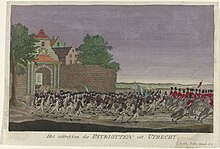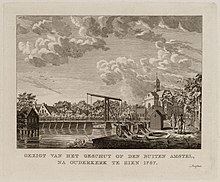You can help expand this article with text translated from the corresponding article in German. (February 2024) Click [show] for important translation instructions.
|
Johann Friedrich von Salm-Grumbach (5 November 1743 - 11 September 1819) was a member of the noble family of Wild and Rhinegrave from the line of Salm-Grumbach. In the mid-1780s, he served as colonel of a legion of the States General of the Netherlands, then of the States of Holland and West Friesland.[2] As the intended successor to Field Marshal Duke Louis Ernest of Brunswick-Lüneburg, who had left the Netherlands in October 1784, he played a significant role in the conflict between the Dutch Patriots and Orangists until mid-September 1787.





Supported by the Patriots, who advocated for a representative representation of the bourgeoisie, he temporarily assumed the position of de facto general and commander-in-chief of the armed forces in Holland in 1786; de jure, Albert van Rijssel was appointed. Later, he commanded several Free Corps in Utrecht until the Prussian invasion of Holland in 1787 strengthened the position of the Stadtholder William V of Orange again. Criticism of Salm's military judgment arose primarily due to the hasty evacuation of Utrecht; afterwards, he was often referred to as a "stylish failure".
For many years, Johann Friedrich von Salm-Grumbach has been confused with Prince Frederick III, Prince of Salm-Kyrburg in various writings, which have been written in several languages.[3][4][5] Contemporaries such as the Duke of Brunswick, his former adjutant Quint Ondaatje, August Ludwig Schlözer, and General Von Pfau,[6][7][8][9][10] as well as many other German historians, hold a different opinion.[11][12][13][14][15][16][17]
Early life
editJohann Friedrich was born to the Rhine Count Karl Walrad Wilhelm zu Salm-Grumbach (1701-1763) and his wife Juliane Franziska, a born Countess of Prösing und Limpurg (1709-1775). He grew up in Henri-Chapelle, close to Aachen. He had numerous siblings and became co-heir of the Limpurg-Sontheim dominion, which was sold to Württemberg in 1781.[18]
Military career
editJohann Friedrich's military career took him into the French army, where he held the rank of Maréchal de camp.[19] In Dutch service, he commanded a battalion of the infantry regiment "Saxe-Gotha" in 1772.[20] However, it was his role as the commander of a legion in 1784 that marked a significant shift.[21] He raised a force of about 1000 soldiers and 450 horsemen[22] and in 1784, he transferred to the service of the States of Holland and West Friesland, an entity of the States General.[23][24] They were dominated by the oppositional Patriot movement, which fought the quasi-monarchical position of the stadtholder in the Dutch Republic of the United Netherlands. In this struggle, the grouping allied itself with the French King Louis XVI.
Johann Friedrich played an important role as a military leader of the Dutch Republic during the era of the Patriots as a negotiator with the Austrian emperor Joseph II, to dismantle the Barrier treaties 1709-1715. As commander of the Rhine Legion formed during the Kettle War in 1784, his troops were responsible for the defense of the republic. The troops included eight companies of cavalry (Hussars and Cuirassiers), two companies of Jaegers and six companies on Foot. In 1786, Holland employed him to maintain an army, but six months later dismissed his regiment to save money. In several cities a fund was set up to support his troops so that Salm, eager to replace the Stadtholder, could remain.[25]
On May 12, 1787 Johann Friedrich led the army to Utrecht, to protect the Patriot revolt meanwhile a "democratic El Dorado". On 7 June Johann Friedrich von Salm-Grumbach was appointed commander-in-chief and Ondaatje as liaison officer.[26] but he was not recognized by all officers.[27][28][29] Salm's new powers were legally controversial.[30] On the 28 June, he marched to Woerden to capture princess Wilhelmina of Prussia, the wife of the Prince of Orange.[31] Salm suggested conquering Palace Soestdijk and besieging Amersfoort.[32] In August 60 French gunners arrived in the city.[33] When Frederick William II of Prussia invaded the Dutch Republic, Frederick left Utrecht on 16 September 1787 and hurried to Uithoorn and Ouderkerk aan de Amstel, without giving battle.[34] On Thursday, September 20, 1787, the Stadtholder and his wife arrived in The Hague.
In Amsterdam Salm's escape was very resented, and if he had arrived there he would certainly have been harmed.[35] This city, to which the Defense Commission had hastily retreated at Salm's request,[36][37] closed the gates to Salm's troops.[38]
Legacy
editThere are different versions of what afterwards. In order to avoid a possible death penalty, Salm decided to flee. He is reported to have hired a boat in Katwijk and reached Hamburg accompanied by Ondaatje. He then visited his brother in Grumbach in the Rhineland-Palatinate.[39] He is then said to have acquired an estate near Bar-le-Duc (Lorraine), which he called “Holland's folly”.
In the summer of 1788, one of the leading patriots Pieter Paulus, on a visit to Paris, refused to admit him.[40] In 1791, Quint Ondaatje, for four months his personal assistant, wrote him an apology.[41]
Frederick endured heavy criticism from Thomas Jefferson: ...a prince without talents, without courage, and without principle. He might have held out in Utrecht for a considerable time, but he surrendered the place without firing a gun, literally run away & hid himself so that for months it was not known what was become of him. Amsterdam was then attacked and capitulated (on 10 October).[42]
References
edit- ^ Het Utrechts Archief
- ^ August Ludwig von Schlözer: Ludwig Ernst, Herzog zu Braunschweig und Lüneburg, kaiserl. königl. und des h. Römischen Reiches FeldMarschall etc.: Ein Aktenmäßiger Bericht […]. 3. Ausgabe, Vandenhoek-Ruprechtscher Verlag, Göttingen 1787, S. 615 (PDF)
- ^ Pierre de Witt (1886) Une Invasion prussienne en Hollande en 1787. Revue des Deux Mondes, 3e période, tome 74, p. 129-164.
- ^ H.T. Colenbrander (1899) De patriottentijd. Deel 3: 1786-1787, Register
- ^ Simon Schama (1977) Patriots and Liberators: Revolution in the Netherlands, 1780-1813, p. 108, 739
- ^ Eclaircissemens importans Concernant le Complot de l'Enlévement des Papiers de S.A.S. Mgr. le Duc de Brunswick, relaas met bewijsstukken van het complot door Varanchan de St.-Génié en de Rijngraaf van Salm Grumbach om belastende documenten van de hertog van Brunswijk in 1785 in handen te spelen van de auditeur-militair van de Republiek te Maastricht. Gedrukt, 1786
- ^ DBNL (1869) Mr. Ph. Jurriaan Quint Ondaatje von M.P.J. Ondaatje, p. 58
- ^ DBNL (1869) Mr. Ph. Jurriaan Quint Ondaatje von M.P.J. Ondaatje, p. 55
- ^ Ludwig Ernst, Herzog Zu Braunschweig Und Lüneburg, kaiserl. königl. und des h. Römischen Reichs FeldMarschall, Göttingen 1787, S. 615
- ^ Theodor Philipp von Pfau (1790) Geschichte des Preussischen Feldzuges in der Provinz Holland im Jahr 1787, S. 7-8
- ^ Gottlob Friedrich Krebel: Europäisches Genealogisches Handbuch. Johann Friedrich Gleditsche Handlung, Leipzig 1790, S. 32 (Google Books)
- ^ Genealogisches und Staats-Handbuch. 65. Jahrgang, Verlag von Johann Friedrich Wenner, Frankfurt am Main 1827, S. 555, 557 (Google Books)
- ^ Hermann Wendel: Die beiden Salm, ein Justizirrtum der Geschichte. In: Frankfurter Zeitung, 24. Februar 1933; vgl. Annales Historiques de la Révolution Française. Vol. 10 (1933), S. 360
- ^ Georg Weber (1888) Allgemeine Weltgeschichte: mit besonderer Berücksichtigung des Geistes- und Culturlebens der Völker und mit Benutzung der neueren geschichtlichen Forschungen. Das Zeitalter der Reformen und Revolutionen, Band 13, S. 385, 387
- ^ Friedrich Christoph Schlosser: Geschiedenis der achttiende eeuw en der negentiende tot den ondergang van het Fransche keizerrijk. Band 3, van Druten & Bleeker, Sneek 1859, S. 304, 309 (Google Books)
- ^ Olaf van Nimwegen (2017) De Nederlandse Burgeroorlog (1748-1815)
- ^ Peter Tomson (2021) Cornelis van Foreest: Beginselvast bestuurder in een tijdperk van revoluties, S. 55
- ^ Bernhard Peter: Ein Erbstreit und die heraldischen Folgen: Das Schicksal des Limpurger Territorium
- ^ Frédéric Schoell: Cours d’histoire des états européens. Band 40: Histoire du XVIII siècle. Duncker et Humblot, Berlin 1833, S. 308
- ^ Jan Willem van Sypesteijn: Geschiedenis van het regiment Hollandsche hussaren. Gebroeders van Cleef, Amsterdam und Den Haag 1849, S. 2
- ^ Arie Rens: Boreel. Het verhaal van een Regiment Huzaren. S. 12
- ^ Guillaume Groen van Prinsterer: Handboek der geschiedenis van het vaderland. Band 3, J. A. Wormser, Amsterdam 1895, Nr. 752
- ^ Friedrich Christoph Schlosser: Geschiedenis der achttiende eeuw en der negentiende tot den ondergang van het Fransche keizerrijk. Band 3, van Druten & Bleeker, Sneek 1859, S. 304, 309
- ^ Arend Stubbe: Uniformen van het Legioen van de Rijngraaf van Salm. Utrecht 1785, Serie von Drucken, Rijksmuseum Amsterdam
- ^ (in Dutch) Christiaens, W. & M. Evers (2002) Patriotse illusies in Amsterdam en Harderwijk, p. 106
- ^ Inventaris van het archief van de Commissie van Defensie te Woerden, 1787
- ^ Paul Krijnen: Pieter Quint Ondaatje. Revolutieleider in Utrecht. 2021, p. 56–58
- ^ Bijdragen tot de geschiedenis der omwenteling in 1787, p. 125
- ^ M. P. J. Ondaatje: Mr. Ph. Jurriaan Quint Ondaatje. In: Vaderlandsche letteroefeningen. Jaargang 1869, p. 55
- ^ Bijdragen tot de geschiedenis der omwenteling in 1787
- ^ (in Dutch) Knoops, W.A. & F.Ch. Meijer (1987) Goejanverwellesluis. De aanhouding van de prinses van Oranje op 28 juni 1787 door het vrijkorps van Gouda, p. 30, 63.
- ^ O. van Nimwegen, Willem V, S. 336
- ^ Hulzen, A. van (1966) Utrecht in de patriottentijd, p. 289
- ^ S. Schama, Patriots and Liberators, Revolution in the Netherland 1780-1813, p. 129-30
- ^ Memorie voor den Rhijngraaf van Salm, p. 25–28
- ^ Bijdragen tot de geschiedenis der omwenteling in 1787, S. 178
- ^ Johannes Steyn: De Leidsman der Jeugt. Vaderlandsche Historie. Band 14, M. Westerman & Zoon, Amsterdam 1840, S. 117 (Google Books)
- ^ Theodor Philipp von Pfau: Histoire de la campagne des Prussiens en Hollande en MDCCLXXVII. Berlin 1790, S. 82 (Google Books)
- ^ (in Dutch) Nieuwe Nederlandse Jaarboeken 1787, 5386.
- ^ (in Dutch) Vles, E.J. (2004) Pieter Paulus (1753–1796) Patriot en Staatsman, p. 84.
- ^ Bijdragen tot de geschiedenis der omwenteling in 1787
- ^ Thomas Jefferson’s Notes on Early Career